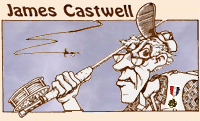|
Probably no single casting problem has had more written about it than the dreaded
'tailing-loop.' It has been the nemesis of fly-casters young and old, new and veteran.
And perhaps some of what has been ventured has been correct, some not really, and
some dead wrong. This points out the great misunderstanding of what causes the problem
and therefore how to correct the problem. The fault lies in the many and varied conditions
which can cause the 'tailing-loop' to result. On August 22, 1999 Al Campbell answered
a question on the FAOL bulletin board involving wind-knots (the inevitable result of a
tailing-loop). I think he did a good job. ~ JC
In Reply to: What Causes Windknots? posted by Mountain phly
(aka MM phlyster) on August 21, 1999 at 23:07:15:
1)"Punching" This is where you jerk the rod rather than smooth acceleration in
your casting. The line doesn't accelerate properly so it wants to die out in both
directions. You compensate by speeding up and a knot forms from the tailing loops
you create. Adjust by accelerating your line smoothly to a sudden stop rather than
jerking the rod to a stop.
2) Dropping your back cast. This can be the result of dropping your shoulder or
tipping your wrist. Adjust by facing your target squarely with your feet together
and lined up toward the target. Now watch your backcast by moving only your head
and eyes. Make sure you aren't tipping your wrist and that the rod is stopping in the
1 o-clock position above you.
3) Rushing your cast. If you start your forward cast while your line is traveling back,
two things will happen: you'll create cute little knots and you'll snap off your fly. Adjust
by watching your line and starting your forward cast when your line extends fully behind
you. If you are punching or tipping your wrist, this will be hard to do. If you can't see your
backcast because it is too low behind you, suspect the possibility that your wrist is tipping.
That will really screw up your timing.
Here's a couple of things that might help:
1) At the start of your backcast, lift then pull. It should be one smooth motion, but the
lift first will bring your line up into the air before it goes behind you.
2) At the start of your forward cast, push rather than tip the rod downward. This will
accelerate the line forward rather than at the water. Line moving in an arch doesn't go
where you want it to go, so make sure the rod tip moves forward first.
3) Count out loud. Count to two before starting your forward cast to get your timing right.
If it is a longer cast it may be a three count, etc. but counting will help you get the timing
down. Beginning musicians count, and this is the same idea.
Mike is right about getting some good instruction, but it doesn't have to be FFF certified
instruction. There are a lot of fine instructors out there who object to the money grubbing
politics of some of the FFF staff. (I am one who objects) Your local fly shop should be
able to help you find instruction. If not, contact JC or Ladyfisher here for help finding an
instructor in your area. They seem to know almost everyone who teaches fly fishing.
Finally, go to the For Beginners area here
and read the wealth of quality information there. About
1/3 of the questions asked on this bulletin board are answered in the
Flyfishing 101 section of that area.
Castwell's columns usually answer most of the rest of the casting questions. You can read
over 100 of them in the archives. ~ AC
|





